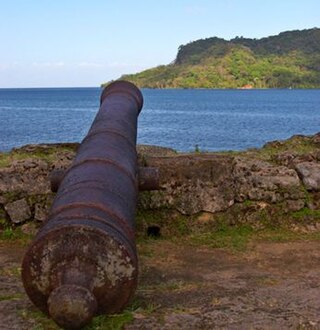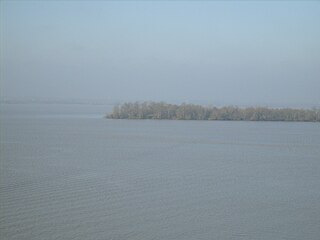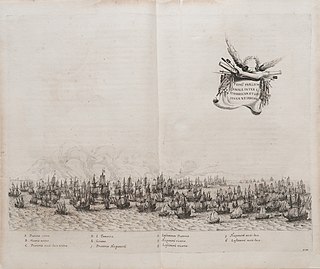
Sir Francis Drake was an English explorer and privateer best known for his circumnavigation of the world in a single expedition between 1577 and 1580. This was the first English circumnavigation, and second circumnavigation overall. He is also known for participating in the early English slaving voyages of his cousin, Sir John Hawkins, and John Lovell. Having started as a simple seaman, in 1588 he was part of the fight against the Spanish Armada as a vice-admiral.

1596 (MDXCVI) was a leap year starting on Monday of the Gregorian calendar and a leap year starting on Thursday of the Julian calendar, the 1596th year of the Common Era (CE) and Anno Domini (AD) designations, the 596th year of the 2nd millennium, the 96th year of the 16th century, and the 7th year of the 1590s decade. As of the start of 1596, the Gregorian calendar was 10 days ahead of the Julian calendar, which remained in localized use until 1923.

The Blockade of Porto Bello was a failed British naval action against the Spanish port of Porto Bello in present-day Panama between 1726 and 1727 as part of the Anglo-Spanish War. The British were attempting to blockade the port to stop the Spanish treasure fleet leaving for Spain with its valuable cargo. However tropical disease took its toll of the seamen to the extent that the British had to leave to re-crew, during which time the Spanish were able to re-commence shipping operations.

The Battle of San Juan de Ulúa was fought between English privateers and Spanish forces at San Juan de Ulúa. The English flotilla of six armed merchant ships under John Hawkins had been trading along the Spanish Main with the cooperation of local Spanish officials. However the central Spanish authorities considered this to be illegal smuggling that violated the Treaty of Tordesillas.

The Battle of Blaye of 1593, also known as the Battle of Bec d'Ambès or Battle of the Gironde Estuary, was a naval Spanish victory that took place on 18 April 1593 off Blaye and Bec d'Ambès, Gironde Estuary, France, during the seven-month siege of Blaye between the French-Protestant forces of Henry of Navarre and the French-Catholic garrison of the city led by Governor Jean-Paul d'Esparbès de Lussan d'Aubeterre, in the context of the Brittany Campaign during the French Wars of Religion and the Anglo-Spanish War (1585–1604).

The recapture of Bahia was a Spanish–Portuguese military expedition in 1625 to retake the city of Bahia in Brazil from the forces of the Dutch West India Company (WIC).

The Battle of Bordeaux was a naval engagement of the Franco-Spanish War of 1635–1659 fought on 20 October 1653 in the Gironde estuary. A Spanish fleet under Álvaro de Bazán, 3rd Marquis of Santa Cruz, sent to relieve Bordeaux, at that time held by the nobles rose up against Louis XIV during the Fronde, encountered a great concentration of French warships belonging to Duke of Vendome's army in the channel of Blaye and captured or destroyed most of it. Shortly after a landing was made by some 1,600 soldiers of the Spanish Tercios which sacked the village of Montagne-sur-Gironde. A similar attempt in the Island of Ré was repulsed, so Santa Cruz, having accomplished his orders, returned to Spain.

The Battle of Santa Cruz de Tenerife was a military operation in the Anglo-Spanish War (1654–60) which took place on 20 April 1657. An English fleet under Admiral Robert Blake penetrated the heavily defended harbour at Santa Cruz de Tenerife in the Spanish Canary Islands and attacked their treasure fleet. The treasure had already been landed and was safe but the English engaged the harbour forts and the Spanish ships, many of which were scuttled and the remainder burnt. Having achieved his aim, Blake withdrew without losing any ships.
The Battle of las Palmas was an unsuccessful English naval expedition in 1595 during the Anglo-Spanish War against the Spanish island of Gran Canaria. The English Fleet was originally directed towards Puerto Rico, but had taken a detour in hopes of an easy victory and taking supplies. The English expeditionary fleet under Francis Drake, Sir John Hawkins, and Sir Thomas Baskerville failed to achieve victory and was forced to withdraw from the Canary Islands towards the Spanish Caribbean, where Francis Drake died of dysentery at Mosquito Gulf.
The action of San Mateo Bay or action of Atacames Bay was a naval engagement which took place from 29 June to 1 July 1594 between the galleon Dainty under the command of English privateer Richard Hawkins and a Spanish squadron of three galleons commanded by Beltrán de Castro at the mouth of the Esmeraldas river, nowadays Ecuador.

The action of 18 February 1639 was a naval battle of the Eighty Years' War fought off Dunkirk between a Dutch fleet under the command of Admiral Maarten Tromp and the Spanish Dunkirk Squadron under Miguel de Horna. Horna, who had orders to join with his ships Admiral Antonio de Oquendo's fleet at A Coruña, escorted at the same time a transport convoy carrying 2,000 Walloon soldiers to Spain, where they were needed. The attempt to exit Dunkirk was done in sight of the Dutch blockading squadron of Maarten Tromp. A 4-hour battle ensued and Horna was forced to retreat into Dunkirk leaving behind two of his galleons, whilst another ran aground. Despite his success in stopping the sortie, many of Tromp's ships suffered heavy damage, and the Dutch Admiral was forced to abandon the blockade. Therefore, De Horna, after repairing his squadron, was able to accomplish his mission.

The action of 12–17 January 1640 was a naval battle between a Dutch fleet and a combined Spanish-Portuguese fleet during the Eighty Years' War. The battle took place on the Brazilian coast off Pernambuco and was an attempt by a fleet consisting of approximately eighty vessels transporting about 5,000 soldiers under the command of Portuguese Admiral Fernando de Mascarenhas to land reinforcements to bolster the Portuguese militia besieging the city of Recife. On 12 January this fleet was intercepted by a Dutch task force of about forty ships commanded by Willem Loos. The ensuing battle lasted with occasional breaks until the evening of 17 January, when the Spanish and Portuguese fleet retreated and sailed away to the north.

Francisco Díaz Pimienta (1594–1652) was a Spanish naval officer who became Captain general of the Ocean Fleet.
The Battle of Guadalupe Island, also known as the Battle of Guadalupe, was a naval action that took place off Guadalupe Island, Caribbean Sea, on 8 November 1595, between a Spanish force of five frigates commanded by Don Pedro Tello de Guzmán and Don Gonzalo Méndez de Cancio, and an English squadron of nine ships, during the unsuccessful English military expedition of 1595 against Spain and their possessions, led by Sir Francis Drake himself, Sir John Hawkins and Sir Thomas Baskerville, as the context of the Anglo-Spanish War (1585–1604). The result was a Spanish victory. One of the English ships, the Francis, was captured and the others fled from the battle. Then, knowing Drake's plans, the Spanish flotilla took advantage over the bulk of Drake's fleet, and arrived at San Juan on 13 November, reinforcing the town with 500 soldiers and supplies. The Spaniards organized different artillery positions in strategic locations, and the five frigates were positioned to cover the entrance of the bay with their artillery, awaiting the arrival of Drake. On 22 November, with the defenses completed, the English fleet arrived off San Juan and tried to invade the town. The result was another Spanish victory over Drake's forces.

The Battle of São Vicente was a minor naval engagement that took place off São Vicente, Portuguese Brazil on 3 February 1583 during the Anglo–Spanish War between three English ships, and three Spanish galleons. The English under Edward Fenton on an expedition having failed to enter the Pacific, then attempted to trade off Portuguese Brazil but were intercepted by a detached Spanish squadron under Commodore Andrés de Equino. After a moonlit battle briefly interrupted by a rainstorm the Spanish were defeated with one galleon sunk and another heavily damaged along with heavy losses. Fenton then attempted to resume trading but without success and thus returned to England.

The Blockade of Western Cuba, also known as the Watts' West Indies Expedition of 1591, was an English privateering naval operation that took place off the Spanish colonial island of Cuba in the Caribbean during the Anglo–Spanish War. The expedition along with the blockade took place between May and July 1591 led by Ralph Lane and Michael Geare with a large financial investment from John Watts and Sir Walter Raleigh. They intercepted and took a number of Spanish ships, some of which belonged to a Spanish plate convoy of Admiral Antonio Navarro, and protected by the Spanish navy under Admiral Diego de la Ribera intending to rid English privateers. The English took or burnt a total of ten Spanish ships including two galleons, one of which was a valuable prize. With this success and the loss of only one ship the blockade and expedition was terminated for the return to England. The blockade was one of the most successful English expeditions to the Spanish Main during the war militarily and financially.

Watts' West Indies and Virginia expedition also known as the Action of Cape Tiburon was an English expedition to the Spanish Main during the Anglo–Spanish War. The expedition began on 10 May and ended by 18 July 1590 and was commanded by Abraham Cocke and Christopher Newport. This was financed by the highly renowned London merchant John Watts. The English ships intercepted and dispersed Spanish convoys capturing, sinking, and grounding many ships off the Spanish colonies of Hispaniola, Cuba, and Jamaica. Despite losing an arm, Newport was victorious and captured a good haul of booty. A breakaway expedition from this discovered that the Roanoke Colony was completely deserted and which gave the name The Lost Colony.

Drake's Assault on Panama also known as the Defence of Panama was a military event that took place in January 1596 during the Anglo–Spanish War. An English expedition under the command of Francis Drake and Thomas Baskerville attacked the Spanish Main via Nombre de Dios in order to cross the isthmus of Panama. Ravaged with dysentery and other diseases the English were repelled and defeated. Drake would die of the former and the expedition was forced to retreat back to England all the while harassed by the Spanish.

Dainty was an English race-built galleon that began to be built in 1588. The original name was Repentance, but this was soon changed. It participated in some naval engagements in the Anglo-Spanish War (1585–1604). In 1593 it sailed from England under Richard Hawkins to navigate the Pacific Ocean and circumnavigate the world, but was captured the following year by the Spaniards when it was sailing off the coast of what is now Ecuador. It was commissioned by the Spaniards as Nuestra Señora de la Visitación, serving in the South Pacific for several years. She was also known informarly by her nickname, La Inglesa.
The Battle of Cabañas was an attempt in 1638 by Dutch privateer Cornelis Jol to capture the Spanish treasure fleet captained by Carlos de Ibarra. The naval battle, framed in the Eighty Years' War, ended with the Dutch fleet retreating after suffering heavy damage.















